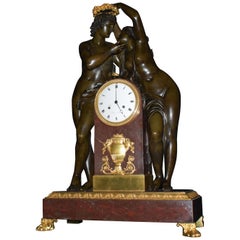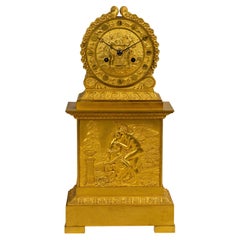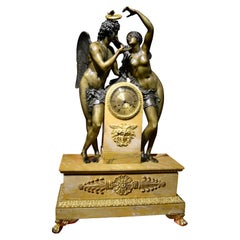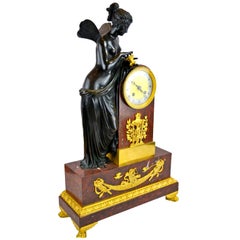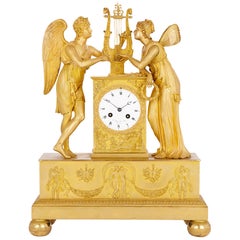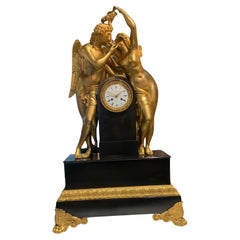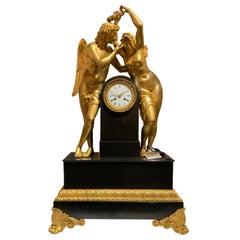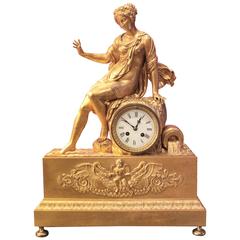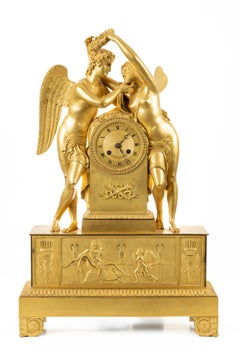Psyche Clock Empire
Antique Early 19th Century French Empire Mantel Clocks
Griotte Marble, Bronze
Antique 19th Century French Clocks
Bronze
Antique Early 19th Century French Empire Mantel Clocks
Siena Marble, Bronze
Antique Early 19th Century French Empire Mantel Clocks
Bronze
Antique 1810s French Empire Mantel Clocks
Enamel, Ormolu, Bronze
Antique 1870s French Empire Mantel Clocks
Bronze
Antique 1870s French Empire Mantel Clocks
Bronze
Recent Sales
Antique 1880s French Empire Mantel Clocks
19th Century Nude Sculptures
Bronze
Antique 19th Century French Empire Mantel Clocks
Marble, Bronze
Antique 19th Century French Empire Mantel Clocks
Marble, Griotte Marble, Bronze, Ormolu
Antique 1820s French Empire More Clocks
Marble, Bronze, Ormolu
Antique 1810s French Empire Mantel Clocks
Bronze
Antique Early 19th Century French Empire Mantel Clocks
Ormolu
Antique 1870s French Empire Mantel Clocks
Bronze
Antique 1820s French Empire Mantel Clocks
Bronze
Antique 19th Century French Empire Mantel Clocks
Marble, Brass, Bronze
Antique Early 19th Century Empire Mantel Clocks
Griotte Marble, Bronze
Antique 19th Century French Empire Mantel Clocks
Bronze
Antique 19th Century French Second Empire Clocks
People Also Browsed
17th Century Old Masters Portrait Paintings
Oil, Wood
Vintage 1970s American Mid-Century Modern Architectural Elements
Brass
17th Century Old Masters Paintings
Oil
21st Century and Contemporary French Art Nouveau Chandeliers and Pendants
Bronze
Antique Early 18th Century French Baroque Western European Rugs
Wool, Silk
Antique Late 19th Century French Romantic Figurative Sculptures
Marble, Bronze
Antique 19th Century French Empire Revival Mantel Mirrors and Fireplace ...
Gesso, Mirror, Wood
Antique Mid-19th Century French Louis Philippe Mantel Mirrors and Firepl...
Gold Leaf
Antique 19th Century Italian Classical Greek Vases
Marble
Antique Late 19th Century English Gothic Doors and Gates
Metal, Iron, Wrought Iron
Antique Late 19th Century French Belle Époque Mantel Clocks
Bronze, Ormolu
Vintage 1930s Austrian Art Deco Night Stands
Bakelite, Walnut, Plywood
Antique 19th Century English Vases
Porcelain
Antique 1890s Italian Neoclassical Decorative Art
Silk, Wood
Vintage 1920s Italian Mid-Century Modern Vases
Art Glass
Antique 1890s French Louis XV Figurative Sculptures
Granite, Bronze
Psyche Clock Empire For Sale on 1stDibs
How Much is a Psyche Clock Empire?
A Close Look at Empire Furniture
From 1804–15, Napoléon I reigned as the emperor of France, bringing the country into a new era of opulence after the fall of the monarchy and the tumultuous years of the French Revolution. He declared, “We must have very solid things, made to last 100 years.” Empire-style furniture followed suit, with imposing pieces constructed from mahogany and adorned with gilded ornaments. Expanding on the neoclassicism popularized in the previous century — such as in Louis XVI style — Empire style borrowed from the great civilizations of antiquity, from Egypt to Greece and Rome, to connect this nascent empire to the power of the past.
Napoléon I believed the production of fine furniture would reflect the stature of the republic, with his official architects Charles Percier and Pierre-François-Léonard Fontaine leading the way with their work on his residences.
Luxurious materials, symmetrical shapes and bold colors characterize antique Empire-style bedroom furniture, armchairs, cabinets and other structures, with frequent motifs including mythological creatures, geometric designs, acanthus leaves, eagles, bees (the imperial emblem) and swans, a favorite of Empress Joséphine.
Flat surfaces, like marble tabletops, were accented with decadent details, such as the bronze furniture mounts made by sculptor Pierre-Philippe Thomire for the French palaces. Martin-Guillaume Biennais, who worked as the imperial goldsmith, crafted intricate luxury objects that mixed wood, fine metal, mother-of-pearl and ivory. Ormolu — or elaborate bronze gilding — was essential to French design in the 18th and 19th centuries as a cornerstone of the neoclassical and Empire styles.
The style became popular abroad, influencing the American Empire style. Stately pieces carved with sprigs of olives by cabinetmaker Pierre-Antoine Bellange were acquired by American President James Monroe for the White House in 1817.
Find a collection of antique Empire tables, lighting, seating and other furniture on 1stDibs.
Finding the Right Mantel-clocks for You
Personal time-telling devices may have migrated from our pockets to our wrists and finally onto our phones, but despite the convenience of a handheld digital timekeeper, nothing can beat well-made vintage, new and antique mantel clocks.
Invented by clockmakers in France and popularized in the 18th and 19th centuries, these practical yet ornate pieces were typically displayed on top of fireplaces or desks. While the most common mantel clocks were created in the traditional tambour style, which features a wide base that flares into an upright drum- or camelback-shaped case, modern clockmakers and furniture designers have experimented with their own ideas for these decorative objects over the years, introducing different forms and working with unconventional materials. A collection of whimsical, monochromatic handmade mantel clocks crafted by Dutch designer Kiki van Eijk, called Floating Frames, for example, features minimalist frames of anodized wire and ceramic clockfaces.
When shopping for an antique, vintage or new mantel clock, don’t be afraid to branch out. Wood mantel clocks of any era will bring a classic, elegant allure to the shelving in your living room or the bookcase in your bedroom, while Empire-style mantel clocks will comparatively boast eye-catching gilt bronze and pronounced sculptural attributes. Some Art Deco mantel clocks will feature an integration of marble or glass and will likely be marked by the decorative embellishments associated with that particular furniture style.
There’s just something about cool clocks, right? Spend your time with an extraordinary collection of mantel clocks on 1stDibs today.
